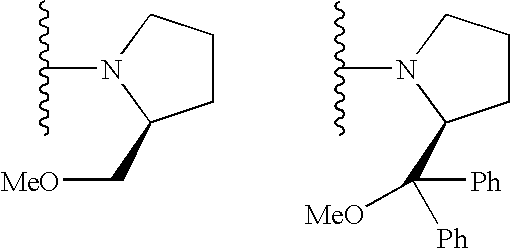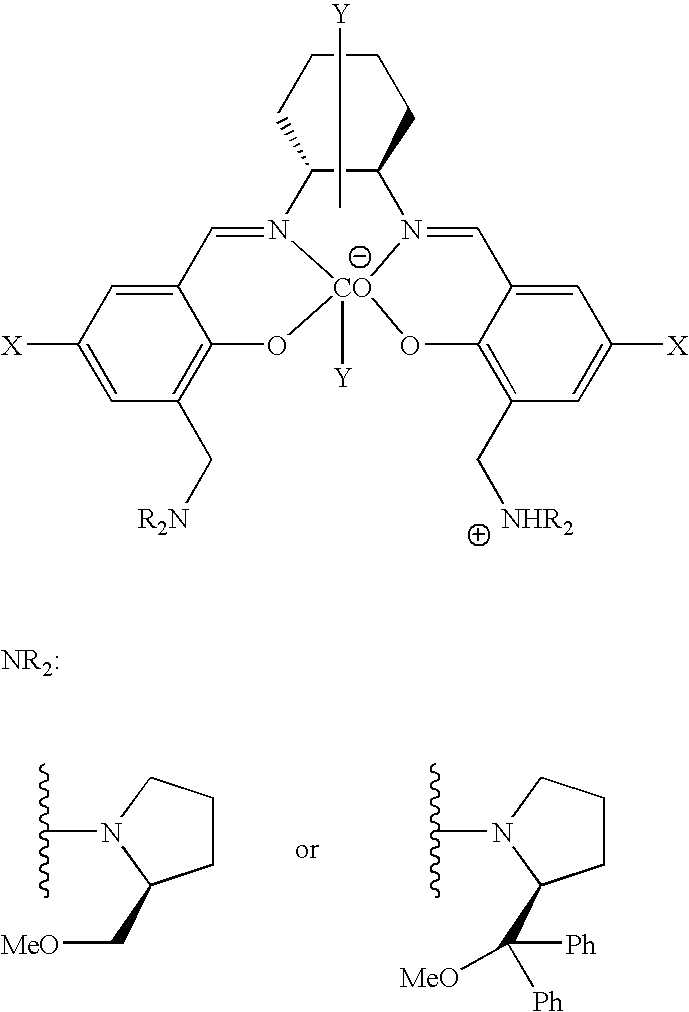Stereoselective alternating copolymerization of epoxide with carbon dioxide
a technology which is applied in the field of alternating copolymerization of epoxide and carbon dioxide to achieve the effect of high enantioselectivity
- Summary
- Abstract
- Description
- Claims
- Application Information
AI Technical Summary
Benefits of technology
Problems solved by technology
Method used
Image
Examples
examples
[0061]The present invention is more specifically explained by the following examples; however, the present invention is not limited to these examples.
[0062]The measurement of 1H NMR spectrum of the compounds obtained in the examples of the present invention was carried out using a JNM-ECP500 (500 MHz) manufactured by JEOL Ltd.
[0063]The molecular weight of optically active polycarbonate was measured by using a high performance liquid chromatography system (DG660B / PU713 / UV702 / RI704 / C0631A) manufactured by GL Sciences Inc., and two Shodex KF-804F columns manufactured by Showa Denko, K.K. with tetrahydrofuran as an eluate (40° C., 1.0 mL / min), standardized with a polystyrene standard, and was obtained by processing the data with analysis software (EZChrom Elite manufactured by Scientific Software, Inc.).
[0064]Further, in the examples of the present invention, the optical purity of the optically active epoxide, which was not reacted, was estimated by the enantiomeric excess percentage (%...
synthesis example a
Synthesis of a Novel Schiff Base Compound
A-1. Synthesis of Salcy Ligand 1b
[0071]
[0072]Under argon gas atmosphere, salicylaldehyde derivative 3 (248 mg, 0.91 mmol) and tetrahydrofuran (10 mL) were put into a 20 mL Schlenk flask, to which (S)-2-(diphenylmethoxymethyl)pyrrolidine [(S)-4, 450 mg, 1.7 mmol] dissolved in tetrahydrofuran (20 mL) was slowly added. After stirring at 25° C. for 2 hours, the resulting precipitate was filtered off, and the filtrate was concentrated to give a salicylaldehyde derivative (S)-5 (384 mg, 84% yield).
[0073]1H NMR (CDCl3, 500 MHz) δ 10.29 (s, 1H), 7.56-7.50 (m, 5H), 7.40-7.29 (m, 8H), 4.36 (d, J=13.5 Hz, 1H), 3.99 (dd, J=9.9, 4.1 Hz, 1H), 3.68 (d, J=13.7 Hz, 1H), 2.96 (s, 3H), 2.38-2.34 (m, 1H), 2.20-2.15 (m, 1H), 2.10-2.02 (m, 1H), 1.86-1.80 (m, 1H), 1.46-1.40 (m, 1H), 1.30 (s, 9H), 0.72-0.62 (m, 1H).
[0074]The obtained salicylaldehyde derivative (S)-5 (178 mg, 0.39 mmol) was dissolved in ethanol (1.0 mL) and methylene chloride (3.0 mL), to which (1R,2...
synthesis example b
Synthesis of a Novel Cobalt-Schiff Base Complex
B-1. Synthesis of Complex 2a
[0076]
[0077]Under argon gas atmosphere, cobalt acetate (29 mg, 0.16 mmol), salcy ligand 1a (110 mg, 0.16 mmol), and dichloromethane (1.0 mL) were put into a 20 mL Schlenk flask. The resulting mixture was stirred at room temperature for 15 min, and then at 35° C. for 2.5 hours. Glacial acetic acid (65 mL) dissolved in dichloromethane (2.0 mL) was added and stirred in the presence of air for 3.5 hours. After removal of volatile components under reduced pressure, followed by sufficient drying, the desired cobalt complex 2a was quantitatively obtained as a red-brown solid.
[0078]1H NMR (CDCl3, 500 MHz) δ 7.64(s, 2H), 7.40 (d, J=2.2 Hz, 2H), 7.29 (d, J=2.2 Hz, 2H), 5.21 (d, J=12.1 Hz, 2H), 4.31 (d, J=12.1 Hz, 2H), 4.12-4.06 (m, 2H), 4.01 (d, J=8.2 Hz, 2H), 3.93-3.88 (m, 2H), 3.76-3.71 (m, 2H), 3.67-3.62 (m, 2H), 3.49-3.41 (m, 6H), 2.91 (d, J=11.0 Hz, 2H), 2.06-1.86 (m, 10H), 1.77-1.68 (m, 4H), 1.60-1.54 (m, 2H), 1....
PUM
 Login to View More
Login to View More Abstract
Description
Claims
Application Information
 Login to View More
Login to View More - R&D
- Intellectual Property
- Life Sciences
- Materials
- Tech Scout
- Unparalleled Data Quality
- Higher Quality Content
- 60% Fewer Hallucinations
Browse by: Latest US Patents, China's latest patents, Technical Efficacy Thesaurus, Application Domain, Technology Topic, Popular Technical Reports.
© 2025 PatSnap. All rights reserved.Legal|Privacy policy|Modern Slavery Act Transparency Statement|Sitemap|About US| Contact US: help@patsnap.com



